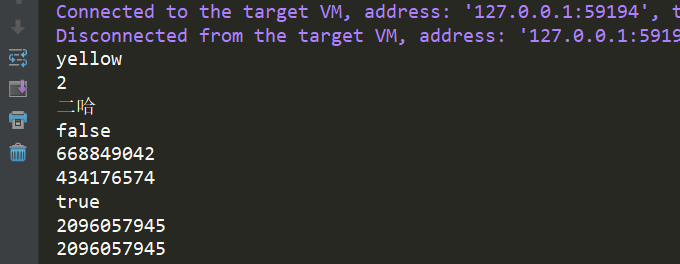浅谈java浅拷贝和深拷贝
2024-10-20 05:46:20
前言:深拷贝和浅拷贝的区别是什么? 浅拷贝:被复制的对象的所有变量都含有原来对象相同的值,而所有的对其他对象的引用仍然指向原来的对象。换言之, 浅拷贝仅仅复制所考虑的对象,而不复制它所引用的对象。深拷贝:被复制对象的所有变量都含有与原来对象相同的值,而那些引用对象的变量将指向被复制过的新对象,而不再是原有 的那些被引用的对象。换言之,深拷贝把要复制的对象所引用的对象都复制了一遍。
浅拷贝
无论是浅拷贝还是深拷贝都要用到clone()方法,所有类都继承于Object,clone方法定义于Object类中但没有实现,
而如果要使用clone方法,根据源码则必须实现Cloneable接口,java.lang.Cloneable是一个标志性接口不包含任何方法,根据注释clone方法是由C或C++其他本地语言实现的。
* @return a clone of this instance.
* @throws CloneNotSupportedException if the object's class does not
* support the {@code Cloneable} interface. Subclasses
* that override the {@code clone} method can also
* throw this exception to indicate that an instance cannot
* be cloned.
* @see java.lang.Cloneable
*/
protected native Object clone() throws CloneNotSupportedException;
实现浅拷贝:
package yunche.test.copy; /**
* @ClassName: Dog
* @Description:
* @author: yunche
* @date: 2018/08/25
*/
public class Dog implements Cloneable
{
public String color;
public int age; /**
* 引用变量
*/
public Erha erha; public static void main(String[] args) throws CloneNotSupportedException
{
Dog d = new Dog();
d.color="yellow";
d.age=2;
d.erha = new Erha();
d.erha.name = "二哈"; //此时clone方法为浅拷贝
Dog copyDog = (Dog)d.clone();
System.out.println(copyDog.color);
System.out.println(copyDog.age);
System.out.println(copyDog.erha.name); //hashcode不同,创建了新对象
System.out.println(d==copyDog);
System.out.println(d.hashCode());
System.out.println(copyDog.hashCode()); //hashcode相同,没有创建新的erha对象,只是复制了引用
System.out.println(copyDog.erha==d.erha);
System.out.println(copyDog.erha.hashCode());
System.out.println(d.erha.hashCode()); } private static class Erha
{
String name;
}
}

深拷贝
深拷贝对于基本数据类型进行值传递,对引用数据类型,创建一个新的对象。并复制其内容。怎么实现深拷贝呢?通常的方案有两种:1.序列化这个对象,再反序列化回来,就可以得到这个新的对象,序列化的规则需要我们自己来写。2.重写clone方法,我们可以对其内部引用类型的变量,再进行一次clone()。
序列化方式
序列化需要实现Serializable接口。
package yunche.test.copy; import java.io.*; /**
* @ClassName: Dog
* @Description:
* @author: yunche
* @date: 2018/08/25
*/
public class Dog implements Cloneable, Serializable
{
public String color;
public int age; /**
* 引用变量
*/
public Erha erha; public static void main(String[] args) throws CloneNotSupportedException
{
Dog d = new Dog();
d.color="yellow";
d.age=2;
d.erha = new Erha();
d.erha.name = "二哈"; Dog copyDog = (Dog)d.deepClone();
System.out.println(copyDog.color);
System.out.println(copyDog.age);
System.out.println(copyDog.erha.name); //hashcode不同,创建了新对象
System.out.println(d==copyDog);
System.out.println(d.hashCode());
System.out.println(copyDog.hashCode()); //hashcode不同,创建新的erha对象,实现了深拷贝
System.out.println(copyDog.erha==d.erha);
System.out.println(copyDog.erha.hashCode());
System.out.println(d.erha.hashCode()); } public Object deepClone()
{
File f = new File("dog.obj");
Object obj =null;
try(FileOutputStream fos = new FileOutputStream(f);
ObjectOutputStream oos = new ObjectOutputStream(fos);
FileInputStream fis = new FileInputStream(f);
ObjectInputStream ois = new ObjectInputStream(fis))
{
oos.writeObject(this);
obj = ois.readObject();
}
catch (FileNotFoundException e)
{
e.printStackTrace();
}
catch (IOException e)
{
e.printStackTrace();
}
catch (ClassNotFoundException e)
{
e.printStackTrace();
}
return obj;
} private static class Erha implements Serializable
{
String name;
}
}

重写clone
package yunche.test.copy; import java.io.*; /**
* @ClassName: Dog
* @Description:
* @author: yunche
* @date: 2018/08/25
*/
public class Dog implements Cloneable
{
public String color;
public int age; /**
* 引用变量
*/
public Erha erha; public static void main(String[] args) throws CloneNotSupportedException
{
Dog d = new Dog();
d.color="yellow";
d.age=2;
d.erha = new Erha();
d.erha.name = "二哈"; //重新clone方法,实现深拷贝
Dog copyDog = (Dog)d.clone();
System.out.println(copyDog.color);
System.out.println(copyDog.age);
System.out.println(copyDog.erha.name); //hashcode不同,创建了新对象
System.out.println(d==copyDog);
System.out.println(d.hashCode());
System.out.println(copyDog.hashCode()); //hashcode不同,创建新的erha对象,实现了深拷贝
System.out.println(copyDog.erha==d.erha);
System.out.println(copyDog.erha.hashCode());
System.out.println(d.erha.hashCode()); } @Override
public Object clone()
{
try
{
Dog dog = (Dog)super.clone();
dog.erha = (Erha) this.erha.clone();
return dog; }
catch (CloneNotSupportedException e)
{
e.printStackTrace();
}
return null;
} public static class Erha implements Cloneable
{
String name; @Override
public Object clone()
{
try
{
return super.clone();
}
catch (CloneNotSupportedException e)
{
e.printStackTrace();
}
return null;
}
}
}

参考资料
https://segmentfault.com/a/1190000010648514
最新文章
- screen命令
- Jmeter教程索引贴
- 【EM】代码理解
- 二分图最大匹配算法-Hopcroft-Karp模板
- 【转】android开发工具Eclipse,androidStudio,adt网盘下载--不错
- (转)使用OpenVPN的一些注意事项
- leetcode problem 11 Container With Most Water
- android 中View, Window, Activity, WindowManager,ViewRoot几者之间的关系
- Java程序员面试题集(116-135)
- A2D规则引擎
- web前端-----第一弹html
- Filter组件开发中的SDK基类分析
- 前端基础之DOM和BOM
- Vue源码之----为什么Vue中Array的pop,push等方法可以reactive,而Array[0]='a'这样的方法不会reactive?
- 微信小程序 - 相对定位和绝对定位 - 相对路径和绝对路径
- 如何一步一步建立CAN通讯
- PowerBI开发 第二篇:数据建模
- 【GDOI2018】所有题目和解题报告
- Java 单例模式的常见应用场景
- 体绘制(Volume Rendering)概述之3:光线投射算法(Ray Casting)原理和注意要点(强烈推荐呀,讲的很好)